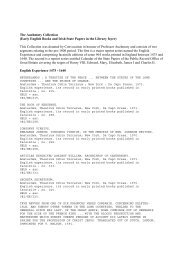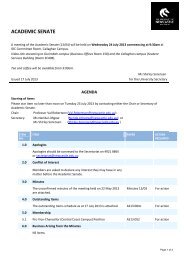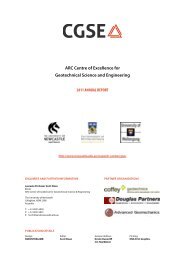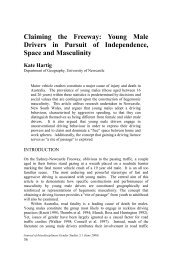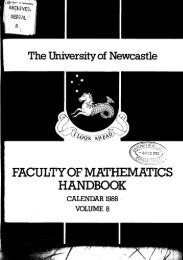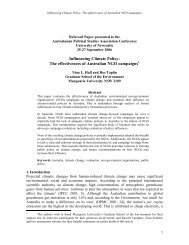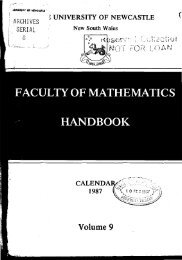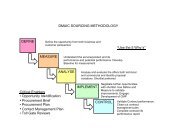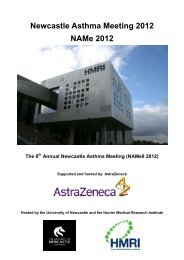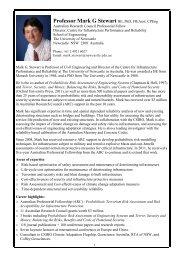n - University of Newcastle
n - University of Newcastle
n - University of Newcastle
You also want an ePaper? Increase the reach of your titles
YUMPU automatically turns print PDFs into web optimized ePapers that Google loves.
11 ISTBODGCTIOS.<br />
the Kelts, a ~ ery ancient tribe ; soon after their first arri~al in<br />
Europe, me fiud the111 occupying Thrace and the countries about<br />
the mouth <strong>of</strong> the Dauube ; bnt fresh iinmi,nratioll from the Cancasus<br />
plateau pushed them up the Danube, then into Belgium<br />
aud Prance, thence iuto Britain, and last <strong>of</strong> all the iarrading<br />
Saxons clrore ttienl ~est\rards into Ireland, and into the mountains<br />
oE TTTales and Scotland. So the successive steps <strong>of</strong> the<br />
ICushite displacement, in my opinion, were these :-first into the<br />
valle~ <strong>of</strong> t?le Ganges, mhere they vere the original inhabitants,<br />
then into the Dcliliall and into Further India, then iilto Ceylon,<br />
the A~ida~an Islands, and the Sunda Islands, and thence into<br />
Sustralia. These stngcs I IT-ill examine presentl?nlore in detail.<br />
Bnt, mean~~hile, lct us 1oolc at the old Bnbylonian Iiingdom.<br />
Its ethnic basis mas ICnshite ; its ruling elpasty continued to be<br />
Kushite probably domn to the time <strong>of</strong> the bwth <strong>of</strong> bbr:tha~il,<br />
abont 2000 B.C. But before that date, the Babylonia11 population<br />
had been nlaterially chanqed. Niulrod had conquered Ere& and<br />
Accad and Calneh in the land <strong>of</strong> Shiuar; ail Llkliadian or Turanian<br />
element was thus incorporated with his eml~ire ; he had built<br />
Nineveh and Xehoboth and Calah and Resell (Genesis x. 11) ; a<br />
Shemite elenlent n7ar thus or in some other way superadded ; other<br />
Turanians and Shemites and Japhetian Aryans too, perhaps attracted<br />
by the easF lururiance <strong>of</strong> life on these fertile plains, had<br />
all assembled in Chaldza and Babylonia. In consequence, 11-e<br />
find that, about twenty centuries B.c., the liushite kingdom had<br />
become a mixed conglomerate <strong>of</strong> four essentially different races-<br />
IIamite, Turaniau. Shemite, and Japhetiau-~liich on the inscriptions<br />
are called xip,.crf-n,.bnf, ' the four quarters.' Then, as<br />
the Babylonian worship <strong>of</strong> DIulitta demanded free intercourse as<br />
a religious duty, a strange mixture <strong>of</strong> pb~sical types must hare<br />
been developetl among the children <strong>of</strong> these races, the Ethiopian,<br />
Scythic, Shemitic, and Iranian a11 blencling--a rare study to the<br />
eye <strong>of</strong> a physiologist, who ~~rould have seen somctimes the one type<br />
sometimes the other predoininatmg in the child. This Chaldzan<br />
monarchy-the first <strong>of</strong> the five great monarchies <strong>of</strong> ancient<br />
history-rras overthro~ra by an irruption <strong>of</strong> Arab (Shemitic)<br />
tribes abont the year 1500 B.C. And now, as I think, another<br />
wave <strong>of</strong> population begrtn to move toxards our shores ; for these<br />
Arabs rrere pure monotheists, and ill their religious zeal must<br />
hare dashed to pieces the polytheistic and sellsun1 fabrlc which<br />
the Babylonian conquests had extended froill the confines <strong>of</strong><br />
India westwards to the Mediterranean (cf. Chedorlao~aer's erpedition,<br />
Genesis riv. 0). Those portions <strong>of</strong> the Chald~o-Babylonian<br />
people that were unable to esc,zl,e from the dominion <strong>of</strong> the Arabs<br />
were absorbecl in the 1l5m empire, just as man? <strong>of</strong> the ICeltic<br />
Britons mere in the sixth and seventh centuries merged in the<br />
newly-formed Saxon kingdoms. But the rupture <strong>of</strong> the Babylo-<br />
nian State and the proscriptiou <strong>of</strong> its ~ or~hip must hare been SO<br />
complete as to drive forth from their native sents thousands <strong>of</strong><br />
the people <strong>of</strong> the four tongues and force then1 11-estxards into<br />
Africa, or eastwards through the mountain passes iuto the tablelaud<br />
<strong>of</strong> PLinjLb, and thence into the Gangetic Plain. Rere, 1<br />
imagine, were already located the pure Hanlites <strong>of</strong> the Dispersion ;<br />
but finding these to be guilty <strong>of</strong> a skin not exactly colourecl like<br />
their omrn, and not uuderatandiay their language, these lattcr<br />
Kushites <strong>of</strong> mixed extraction regarded them as enelnies and drore<br />
them before them into the ~noulltaills <strong>of</strong> the Dclrlian, where, to this<br />
hour, the Dravidians aild liolaria~ls are black-skinned and savay<br />
races. Ere long, these Babylonian Icushites were themselres displaced<br />
and ejected fr~m the Ganges valley by a fair-skinned race,<br />
the Arpans, another and the last ethnic stream <strong>of</strong> invaders fro111<br />
the north-west. These Arj-ans, iu religiolz and habits irreconcilably<br />
opposed to the earlier races <strong>of</strong> India, ~I~zged on them a<br />
releiltIess xar. Hemnecl up in the triangle <strong>of</strong>' southerll Inclia, the<br />
earlier Hamiter could escape only by sea; the Babylonian<br />
Kushites, on the other hand, could not seek safety in the mountains<br />
<strong>of</strong> the DeliIran, as these -irere already occupied ; they must<br />
therefore have been pushed down the Ganges Into Further India<br />
and the dlalayan penir~sula; thence they pzssed at a later time<br />
into Borneo, and the Sunda Islands, and Papus, aud afterwards<br />
across the sea <strong>of</strong> Tilnor into Anrtralin, or eastxarda into Dlelanesin,<br />
driven on~varils nonr by the Turanian tribes, which hacl<br />
come doxu from Central Asia, into China and the Pellinsula and<br />
islands <strong>of</strong> the East Indies.<br />
DImy arguments could be acl~anced in farour <strong>of</strong> this T iem <strong>of</strong><br />
the origin <strong>of</strong> the ,lustralian mce, but the aiscussioll 11-ould be a<br />
lengthy one, aid this is scarcelJT the place for it. I may, liomerer,<br />
be permitted to add here a ~il.;lple iucidellt in my own<br />
experience. h few nlonths ago, I as staying for a n-hile wit11 s<br />
friend in the bush, far fro111 the maiu roads <strong>of</strong> the color~y and<br />
from tom-11s ancl ~~illages. One cla~, Iwhen out <strong>of</strong> doors and alone,<br />
I s a a ~ blnclc ~ man alll~roachil1g ; his curly hair. his features, his<br />
colonr, and his gelleral physique, all said that he was an hustraliai~,<br />
but his gait did not corresl~ond. I \xTas 011 the point <strong>of</strong><br />
addressing hi111 as he drew near, but Ire anticipated me and spolce<br />
first; the tones <strong>of</strong> his voice showed me that I was mistaken. I<br />
at once suspected hinl to be a ICaliuga from the Presidency <strong>of</strong><br />
Madras. And he vas a Iialinga. This incident tells its om-11<br />
tale. In short, it appesrs to me that the Dravidiails and some<br />
tribes among the Kiinalayas are the represe~ltatives <strong>of</strong> the ancient<br />
Dasyus, who resisted the L4ry,a11 inrasion <strong>of</strong> India, and 117110111 the<br />
Puranas describe as akin to beasts. The existence, also, <strong>of</strong><br />
cyclopean rewains in Ponape <strong>of</strong> the Caroline Islands, and elsewhere<br />
onward through the Pacific Ocean, even as far as Easter



